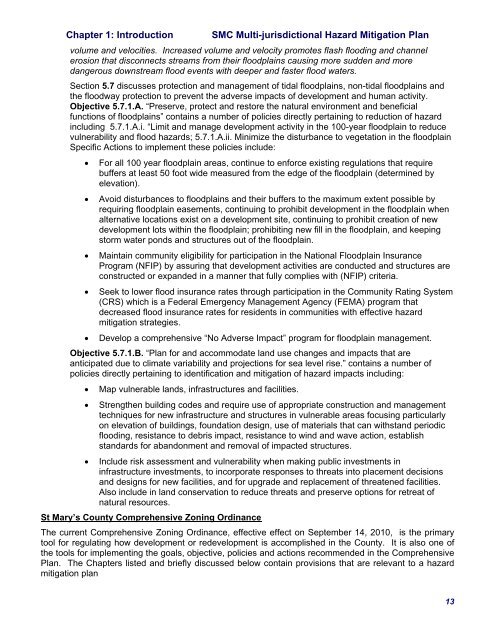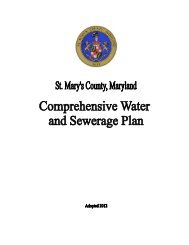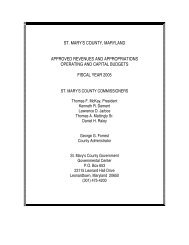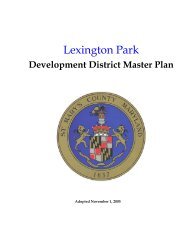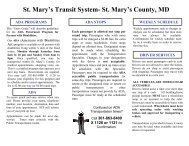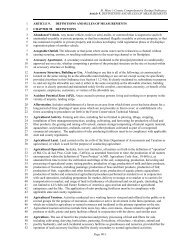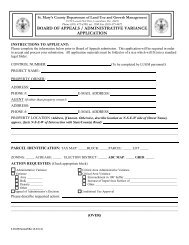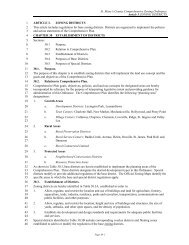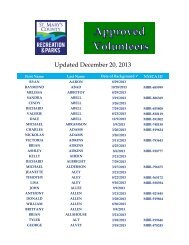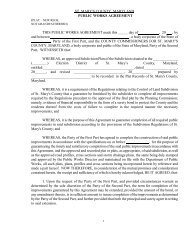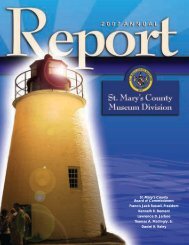St. Mary's County Multi-Jurisdictional Hazard Mitigation Plan
St. Mary's County Multi-Jurisdictional Hazard Mitigation Plan
St. Mary's County Multi-Jurisdictional Hazard Mitigation Plan
You also want an ePaper? Increase the reach of your titles
YUMPU automatically turns print PDFs into web optimized ePapers that Google loves.
Chapter 1: Introduction<br />
SMC <strong>Multi</strong>-jurisdictional <strong>Hazard</strong> <strong>Mitigation</strong> <strong>Plan</strong><br />
volume and velocities. Increased volume and velocity promotes flash flooding and channel<br />
erosion that disconnects streams from their floodplains causing more sudden and more<br />
dangerous downstream flood events with deeper and faster flood waters.<br />
Section 5.7 discusses protection and management of tidal floodplains, non-tidal floodplains and<br />
the floodway protection to prevent the adverse impacts of development and human activity.<br />
Objective 5.7.1.A. “Preserve, protect and restore the natural environment and beneficial<br />
functions of floodplains” contains a number of policies directly pertaining to reduction of hazard<br />
including 5.7.1.A.i. “Limit and manage development activity in the 100-year floodplain to reduce<br />
vulnerability and flood hazards; 5.7.1.A.ii. Minimize the disturbance to vegetation in the floodplain<br />
Specific Actions to implement these policies include:<br />
• For all 100 year floodplain areas, continue to enforce existing regulations that require<br />
buffers at least 50 foot wide measured from the edge of the floodplain (determined by<br />
elevation).<br />
• Avoid disturbances to floodplains and their buffers to the maximum extent possible by<br />
requiring floodplain easements, continuing to prohibit development in the floodplain when<br />
alternative locations exist on a development site, continuing to prohibit creation of new<br />
development lots within the floodplain; prohibiting new fill in the floodplain, and keeping<br />
storm water ponds and structures out of the floodplain.<br />
• Maintain community eligibility for participation in the National Floodplain Insurance<br />
Program (NFIP) by assuring that development activities are conducted and structures are<br />
constructed or expanded in a manner that fully complies with (NFIP) criteria.<br />
• Seek to lower flood insurance rates through participation in the Community Rating System<br />
(CRS) which is a Federal Emergency Management Agency (FEMA) program that<br />
decreased flood insurance rates for residents in communities with effective hazard<br />
mitigation strategies.<br />
• Develop a comprehensive “No Adverse Impact” program for floodplain management.<br />
Objective 5.7.1.B. “<strong>Plan</strong> for and accommodate land use changes and impacts that are<br />
anticipated due to climate variability and projections for sea level rise.” contains a number of<br />
policies directly pertaining to identification and mitigation of hazard impacts including:<br />
• Map vulnerable lands, infrastructures and facilities.<br />
• <strong>St</strong>rengthen building codes and require use of appropriate construction and management<br />
techniques for new infrastructure and structures in vulnerable areas focusing particularly<br />
on elevation of buildings, foundation design, use of materials that can withstand periodic<br />
flooding, resistance to debris impact, resistance to wind and wave action, establish<br />
standards for abandonment and removal of impacted structures.<br />
• Include risk assessment and vulnerability when making public investments in<br />
infrastructure investments, to incorporate responses to threats into placement decisions<br />
and designs for new facilities, and for upgrade and replacement of threatened facilities.<br />
Also include in land conservation to reduce threats and preserve options for retreat of<br />
natural resources.<br />
<strong>St</strong> Mary’s <strong>County</strong> Comprehensive Zoning Ordinance<br />
The current Comprehensive Zoning Ordinance, effective effect on September 14, 2010, is the primary<br />
tool for regulating how development or redevelopment is accomplished in the <strong>County</strong>. It is also one of<br />
the tools for implementing the goals, objective, policies and actions recommended in the Comprehensive<br />
<strong>Plan</strong>. The Chapters listed and briefly discussed below contain provisions that are relevant to a hazard<br />
mitigation plan<br />
13


